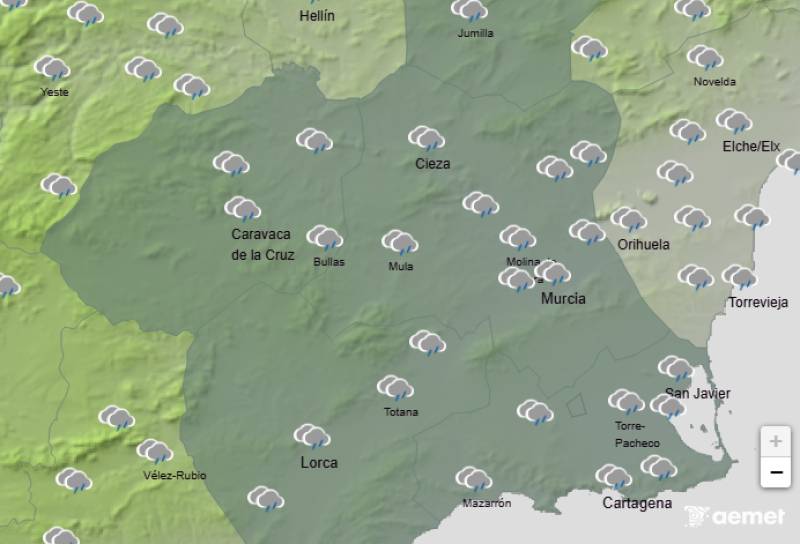
To be listed on the CAMPOSOL TODAY MAP please call +34 968 018 268.
ARCHIVED - Beware; processionary caterpillars are on the move again
Although the regional government and local councils have been spraying throughout the winter, there have been reports over the weekend that the caterpillars are once again on the move in some areas

Readers are reporting the presence of processionary caterpillar nests on urbanisations and in wooded areas near to their homes, and although initiatives are being carried out by both the regional government as well as local councils to remove and treat these dangerous spring visitors, it’s important for anyone who is spending their first winter/spring in Spain to be aware of just how dangerous these seemingly innocuous caterpillars actually are, particularly for their pets.
The pine processionary (Thaumetopoea pityocampa) is so called because members of the species in the caterpillar phase of their life cycle, before they metamorphose into moths, form nose-to-tail processions as they leave their soft cocoon nest of spun filaments, and is widespread throughout the warmer Mediterranean areas of Spain and other parts of Europe.
The favoured nesting grounds of processionary caterpillars are higher up in pine trees, where the nests are closer to the winter sun, and it is normally in late winter and early spring that the caterpillars drop from the cocoon nests and form "processions" in search of soft, warm earth in which to pupate. There can be hundreds of caterpillars nose to tail, winding along roadways or rough ground, and although they may appear innocuous they can be lethal to animals and cause serious reactions in humans, especially young children.
This is because the caterpillars have brittle poisonous and irritant hairs on their bodies which can easily be ejected should they feel threatened. These hairs penetrate the skin easily and cause instant irritation.
The caterpillars are a mottled dull brown with faded yellowish patches but are instantly identifiable as they travel in chains along the ground.
Dogs and cats are often attracted by the bittersweet smell and taste of the processionaries, and both may try to eat them. The results can be fatal; as few as three or four will kill a medium-sized dog, and just one may produce death in a cat as the hairs become embedded in the tongue of the animal, causing necrosis. By the time the owner notices the problem, it is usually too late for veterinary treatment to do much except ease suffering.
Initial symptoms to watch out for in a pet include vomiting and tongue swelling, although it is often immediately apparent that there is a problem as the animal will attempt to rub off the hairs of the caterpillar, which only irritates the inflammation further.

It is highly advisable not to walk dogs in areas where there are large numbers of processionaries, as loose hairs on the floor can be just as lethal for an animal, and it is certainly vital to keep pets on the lead in forests where there are processionaries on the march.
Although spraying has been underway throughout the winter in the areas most generally affected, the regional Ministry of Water, Agriculture, Livestock, Fisheries and the Environment has begun land treatments to combat the pine processionary in public forests in the Region of Murcia.
The General Directorate of Natural Environment plan for the 2020-2023 period consists of three phases: aerial treatments (9,200 hectares), land treatments (3,440 hectares) and an integrated control program, with a total investment of 1,153,000 euros , financed largely by the EAFRD fund of the European Union.
In October 2020, 2,300 hectares were treated with aerial spraying and treatments are now underway at ground level on 860 hectares in the municipalities of Murcia, Bullas, Pliego and Albudeite.
As part of the selection process for the areas to be treated, a database has been created in which the larval state and the type of treatment to be carried out are recorded, in areas previously selected by Forestry Agents, through geographic information systems ( SIG), with visits to all forest regions. For the treatments, Cypermethrin, a broad spectrum non-systemic insecticide, will be used.
This insecticide will be applied in those areas in which, due to the influx of public, the presence of the processionary may entail some type of risk to people's health.
The plan also includes complementary actions such as the placement of 200 nest boxes for birds, with the aim that they can be colonized by birds (chickadees and blue tit) mainly , as well as other small species of insectivorous birds (flycatchers, tree sparrow, nuthatch, among others) which are very effective as controllers of pests of all kinds. The nest boxes will be georeferenced to carry out their annual monitoring as well as for their future maintenance.

Disposal of processionary caterpillars
These animals are most vulnerable whilst still in their silvery nests high up in the pine trees, so this is the best time to dispose of them. Wearing eye protection, gloves, and covering as much skin as possible, cut the nest carefully out of the tree with long handled pruners, attempting to keep the nest intact, put it in a plastic bag and throw it in a bin.
If the nests are low down, spraying with hair spray first will stop the hairs flying off and spraying with insect spray or fly spray before putting in a plastic bag helps to eliminate them completely.
Do NOT touch with bare hands; use disposable gloves, preferably thick rubber or plastic, and definitely do not use cotton gloves as the hairs can stick to these and continue to irritate.
Knocking the nests out of the tree is very dangerous, as the hairs can fly around in the air and settle on the ground, where they can be picked up by animals and also cause irritation for humans, particularly those who fail to wear goggles.
Burning is not advisable unless you have a hot fire going which can incinerate the branches immediately. Lighting a bonfire containing the nests still gives the opportunity for hairs to fly into the air.
Once the caterpillars are on the ground they are very dangerous, as everywhere they go they leave trails which are enough to kill a dog or cat.




























